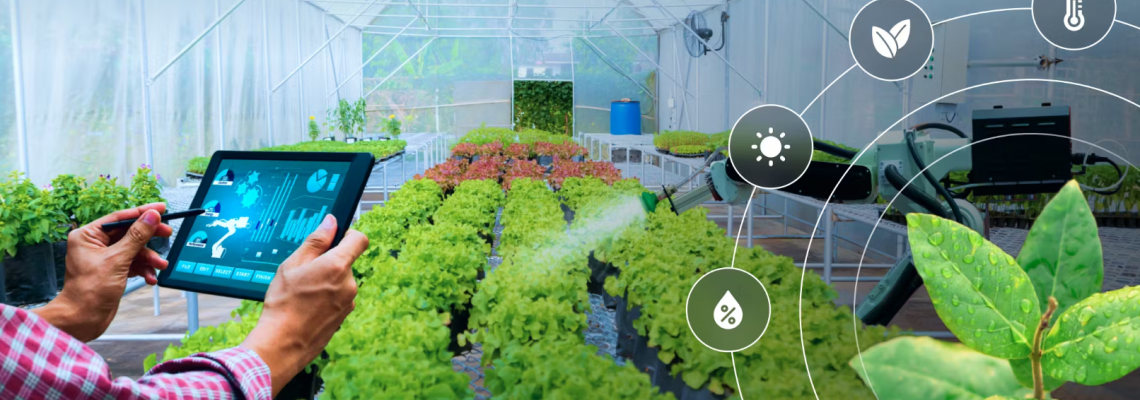
Agriculture has always thrived on innovation. From ancient irrigation systems to modern tractors, each advancement has reshaped farming into a more efficient, productive, and sustainable practice. Today, the next major shift is happening through smart farming—a powerful combination of IoT (Internet of Things), automation, and precision-driven technologies that are transforming how crops are grown.
Among the many innovations fueling this revolution, lighting stands out as a critical factor. For decades, High-Pressure Sodium (HPS) lamps dominated greenhouses and indoor farms, prized for their intensity and affordability. However, their limitations are becoming increasingly clear in today’s data-driven world. HPS fixtures generate excessive heat, lack flexibility, and offer no real compatibility with advanced automation systems.
Enter LED grow lights, designed for the modern age of smart farming. Unlike HPS, LEDs provide precise control over light spectra and intensity, consume far less energy, and last significantly longer. More importantly, they integrate seamlessly with IoT-based systems, enabling real-time adjustments based on plant needs, environmental conditions, and growth stages.
This blog dives into how LED technology outshines HPS in IoT integration, energy efficiency, automation, and adaptability, proving why LEDs are the lighting backbone of smart, sustainable farming.
The Rise of Smart Farming
Smart farming isn’t just about replacing manual labor with machines. It’s about creating an ecosystem where sensors, data, and automation work together to make farming more predictable and sustainable. Key components include:
IoT Sensors: Monitor soil moisture, light levels, plant growth, and environmental conditions.
Automation Systems: Control irrigation, lighting, and ventilation without human intervention.
Data Analytics & AI: Provide insights to improve yield, reduce waste, and cut costs.
For this ecosystem to function, all systems must be precise, responsive, and adaptable. This is where LEDs shine.
Why HPS Lights Fall Short in Smart Farming
HPS lamps were once a reliable solution, offering high light intensity at a relatively low upfront cost. However, they struggle in a smart farming setup due to:
Lack of Spectral Control – HPS emits a broad orange-yellow light that can’t be fine-tuned to specific plant needs.
Heat Production – They generate significant heat, making it harder to maintain optimal greenhouse conditions.
Limited Lifespan – HPS bulbs have a relatively short lifespan, degrading quickly (10K–20K hours), which requires frequent replacements.
No Automation Compatibility – HPS lights are essentially “on/off” systems, unable to integrate with sensors or variable schedules.
In a data-driven environment where every variable counts, these limitations make HPS less compatible with modern IoT frameworks.
The LED Advantage in IoT & Automation
1. Spectral Precision & Customization
LEDs allow growers to tailor light wavelengths—from blue for vegetative growth to red and far-red for flowering. IoT integration makes this even more powerful:
Sensors detect plant growth stages.
Automated systems adjust the spectrum accordingly.
Crops receive exactly what they need at every stage.
This level of control is impossible with HPS.
2. Dynamic Light Intensity Control
Smart LEDs don’t just switch on and off—they can dim, brighten, or adjust intensity in real time. For example:
During cloudy conditions, LEDs can increase intensity to maintain optimal light levels.
As plants mature, lighting schedules can be automatically adjusted.
Night interruptions can be programmed to encourage flowering in long-day crops.
This adaptability reduces energy waste and enhances crop performance.
3. Heat Management & Energy Efficiency
One of the biggest drawbacks of HPS lighting is excessive heat output. LEDs, by contrast:
It produces far less radiant heat.
Lower cooling and HVAC costs in greenhouses.
Create safer working environments for growers.
With IoT integration, temperature sensors can sync with LED systems, ensuring crops never experience heat stress while minimizing energy bills.
4. Extended Lifespan & Reduced Maintenance
HPS bulbs require frequent replacement, which disrupts operations and incurs recurring costs. LEDs, with lifespans of 50,000+ hours, integrate perfectly into automated farming:
Fewer replacements mean less manual labor.
Consistent light output ensures crops aren’t disrupted.
Maintenance costs drop significantly.
When paired with IoT tracking, growers can monitor light degradation and schedule replacements proactively.
5. Seamless Integration with Smart Systems
LED grow lights can connect directly to IoT ecosystems, enabling automation such as:
Light + Irrigation Sync: When light intensity increases, irrigation adjusts automatically to balance plant transpiration.
Climate Control: LEDs work alongside fans, vents, and HVAC to stabilize conditions.
Remote Access: Growers can monitor and adjust lighting from smartphones or dashboards.
This kind of integration creates a self-regulating environment—a game-changer for precision farming.
Real-World Applications of LED Smart Farming
Greenhouses: LEDs adjust to seasonal changes, supplementing natural light efficiently.
Vertical Farms: IoT-driven LEDs provide optimal light in multilayer systems, where sunlight is absent.
Research Facilities: Scientists use LEDs with precise spectral control for crop experiments.
Commercial Agriculture: Large-scale farms cut costs by automating lighting schedules and minimizing energy waste.
Case Example: LEDs in Action
A greenhouse using HPS lighting switched to IoT-enabled LED fixtures. The results:
Energy savings: 40% reduction in electricity costs.
Productivity boost: Faster crop cycles due to optimized spectra.
Maintenance cut: No bulb changes for over five years.
Automation: Sensors now manage lighting, irrigation, and temperature without manual oversight.
This showcases how LEDs not only outperform HPS but also enable full-scale smart farming integration.
The Sustainability Edge
Governments and consumers alike are pushing for eco-friendly farming practices. LEDs contribute by:
Lowering carbon footprints through reduced energy consumption.
Reducing waste from frequent bulb replacements.
Supporting sustainable production without compromising yields.
HPS, by comparison, continues to strain both budgets and the environment.
Conclusion
The debate between HPS and LED lighting is no longer just about upfront cost, it’s about long-term efficiency, adaptability, and compatibility with the future of agriculture.
HPS may be cheaper upfront, but its inefficiency, heat output, and lack of automation make it a poor fit for smart farming.
LEDs offer precision, energy savings, longevity, and IoT compatibility, making them the clear winner in automation-driven agriculture.
As farming moves toward full digital integration, LEDs aren’t just an upgrade; they’re a necessity for those who want to stay competitive, sustainable, and profitable.

Leave a Comment